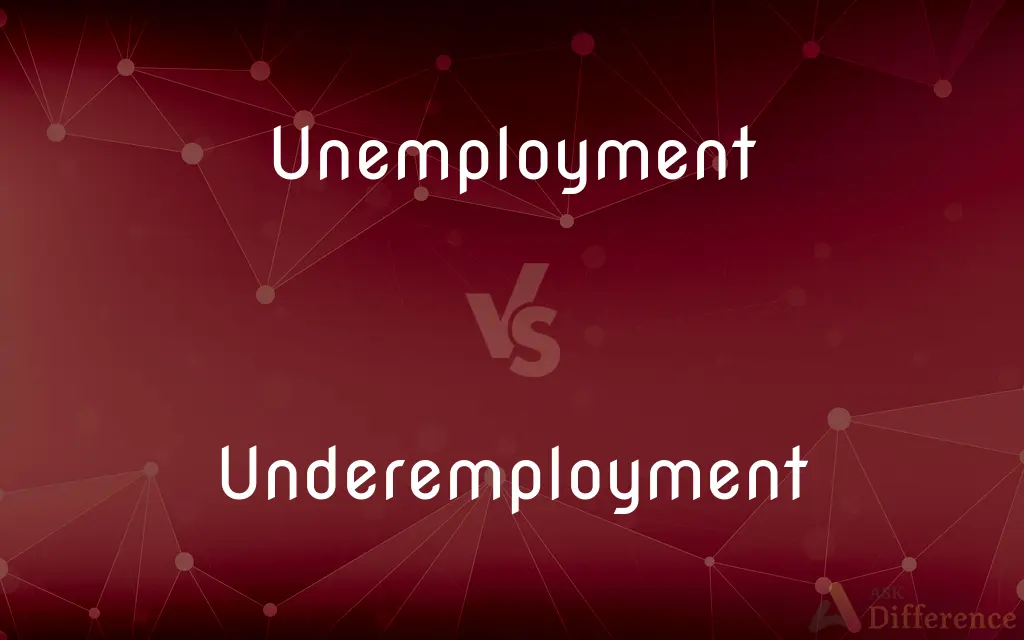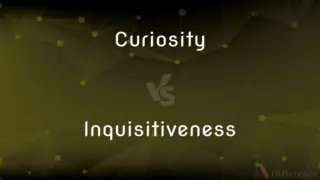Unemployment vs. Underemployment — What's the Difference?
By Tayyaba Rehman — Updated on September 28, 2023
Unemployment is the state of being jobless; underemployment occurs when people have jobs that are inadequate in terms of pay, hours, or utilization of skills.

Difference Between Unemployment and Underemployment
Table of Contents
ADVERTISEMENT
Key Differences
Unemployment and underemployment are two distinct states describing the inadequacy of work. Unemployment is characterized by a lack of employment, where individuals capable of working and actively seeking employment are unable to find work. It represents a state where the labor potential is untapped, often leading to financial instability and economic strain for the unemployed individual. Unemployment is typically measured by the unemployment rate, which is the percentage of the labor force that is unemployed and actively seeking employment.
Conversely, underemployment is the condition where individuals are employed but not to their full capacity, either in terms of hours, compensation, or skill level. Underemployment includes situations where highly skilled individuals are working in low-paying or low-skill jobs and part-time workers desiring full-time employment. Underemployment signifies a suboptimal utilization of the workforce’s skills and abilities, leading to diminished income and career prospects for the underemployed individual.
While both unemployment and underemployment imply a lack of adequate work, the nature of inadequacy varies. Unemployment is about the absence of work, reflecting a total underutilization of labor resources, whereas underemployment implies the presence of work but in a diminished or suboptimal capacity, reflecting partial underutilization of labor resources. Both conditions have significant economic and social implications, such as reduced income, lowered economic output, and increased poverty and inequality.
Understanding the difference between unemployment and underemployment is critical for forming effective labor policies and addressing workforce-related issues. Recognizing unemployment as a complete lack of employment and underemployment as employment that is inadequate in terms of hours, pay, or use of skills provides a nuanced view of labor market dynamics and informs strategies to optimize workforce utilization and enhance economic well-being.
Comparison Chart
Definition
The condition of being jobless and seeking work.
Having inadequate work in terms of pay, hours, or skills.
ADVERTISEMENT
Work Status
No employment.
Employed but in suboptimal conditions.
Utilization of Skills
N/A as there is no employment.
Often involves underutilization of skills.
Economic Implication
Loss of income, decreased economic activity.
Reduced income and suboptimal economic contribution.
Measurement
Unemployment rate: percentage of jobless in labor force.
Difficult to quantify precisely due to varied forms.
Compare with Definitions
Unemployment
The state of being without a job and actively seeking one.
The economic downturn led to a high level of unemployment in the country.
Underemployment
Can include both overqualified individuals in low-skill jobs and part-time workers seeking full-time employment.
Many in the gig economy are facing underemployment, unable to secure stable, full-time positions.
Unemployment
Typically quantified by the unemployment rate.
The government is implementing policies to reduce the unemployment rate in the region.
Underemployment
Often leads to diminished income and career prospects.
Underemployment has forced him to take up multiple jobs to sustain himself financially.
Unemployment
A reflection of the availability of work in the economy.
Rising unemployment often indicates a contracting economy with fewer job opportunities.
Underemployment
Represents the suboptimal utilization of the workforce's skills and abilities.
The engineer, working as a call center agent, is a case of underemployment, with his skills being underutilized.
Unemployment
Can lead to financial strain and decreased quality of life for individuals.
The prolonged period of unemployment has made it difficult for him to meet his basic needs.
Underemployment
The state of having a job that is inadequate, typically in terms of hours, pay, or skill level.
The recent graduate, unable to find a job in her field, is experiencing underemployment by working part-time in a retail store.
Unemployment
Unemployment, according to the OECD (Organisation for Economic Co-operation and Development), is people above a specified age (usually 15) not being in paid employment or self-employment but currently available for work during the reference period.Unemployment is measured by the unemployment rate, which is the number of people who are unemployed as a percentage of the labour force (the total number of people employed added to those unemployed).Unemployment can have many sources, such as the following: new technologies and inventions the status of the economy, which can be influenced by a recession competition caused by globalization and international trade policies of the government regulation and marketUnemployment and the status of the economy can be influenced by a country through, for example, fiscal policy. Furthermore, the monetary authority of a country, such as the central bank, can influence the availability and cost for money through its monetary policy.
Underemployment
Impacts economic productivity due to the misalignment of skills and job requirements.
The high levels of underemployment are leading to a waste of human capital and reduced economic output.
Unemployment
The state of being unemployed, especially involuntarily.
Underemployment
Underemployment is the underuse of a worker because a job does not use the worker's skills, is part-time, or leaves the worker idle. Examples include holding a part-time job despite desiring full-time work, and overqualification, in which the employee has education, experience, or skills beyond the requirements of the job.Underemployment has been studied from a variety of perspectives, including economics, management, psychology, and sociology.
Unemployment
The percentage or number of people who are involuntarily unemployed
Unemployment has been shrinking throughout the recovery.
Underemployment
Employed only part-time when one needs and desires full-time employment.
Unemployment
Unemployment insurance.
Underemployment
Employed at a low-paying job that requires less skill or training than one possesses.
Unemployment
The state of having no job; joblessness.
Unemployment made Jack depressed.
Underemployment
Underemployed persons considered as a group. Used with the.
Unemployment
The phenomenon of joblessness in an economy.
Unemployment has been considered a cause of crime.
Underemployment
The condition of being underemployed.
Unemployment
The level of joblessness in an economy, often measured as a percentage of the workforce.
Unemployment was reported at 5.2% in May, up from 4.9% in April.
Unemployment
(countable) A type of joblessness due to a particular economic mechanism.
All unemployments, seasonal, frictional, cyclical, classical, whatever, mean that you're out of work.
Unemployment
(countable) An instance or period of joblessness.
Until then his life had consisted of low-paying jobs, numerous unemployments, and drug use.
Unemployment
Quality or state of being not employed; - used esp. in economics, of the condition of various social classes when temporarily thrown out of employment, as those engaged for short periods, those whose trade is decaying, and those least competent.
Unemployment
The state of being unemployed or not having a job;
Unemployment is a serious social evil
The rate of unemployment is an indicator of the health of an economy
Unemployment
A socio-economic condition representing the unutilization of available labor force.
Persistent unemployment is often correlated with increased rates of poverty and inequality.
Common Curiosities
Is underemployment the same as unemployment?
No, underemployment refers to inadequate employment in terms of pay, hours, or skill level, while unemployment is the state of being without a job.
Is a high unemployment rate always indicative of economic distress?
Often, yes. High unemployment typically indicates economic contraction, lack of job opportunities, and can lead to increased poverty and inequality.
Can underemployment include overqualified individuals?
Yes, underemployment includes individuals working in jobs for which they are overqualified in terms of skills and education.
Does unemployment always mean a lack of job offers?
No, unemployment can also occur when individuals are unwilling to accept available jobs due to various reasons like inadequate pay or poor working conditions.
Can underemployment occur with a full-time job?
Yes, underemployment can occur when individuals work full-time in roles that underutilize their skills or in jobs with inadequate pay.
Can underemployment affect economic productivity?
Yes, underemployment can lead to suboptimal economic productivity due to the underutilization of skills and labor.
Can unemployment exist in a growing economy?
Yes, unemployment can exist in growing economies due to factors like technological advancements leading to job displacement, structural changes in the economy, or mismatch of skills.
Is underemployment easier to resolve than unemployment?
Not necessarily, resolving underemployment requires addressing mismatches between skills and job requirements and may involve education, training, and structural adjustments in the economy.
Can an increase in part-time jobs lead to underemployment?
Yes, if workers desire full-time positions but can only find part-time jobs, it can lead to underemployment.
Does unemployment include those not seeking employment?
No, the unemployed are typically defined as those without a job but actively seeking employment.
Can unemployment lead to social problems?
Yes, prolonged unemployment can lead to a range of social problems including increased crime, mental health issues, and societal unrest.
Can underemployment reflect a lack of full-time job opportunities?
Yes, underemployment can reflect a situation where individuals are unable to find full-time job opportunities and settle for part-time or inadequate employment.
Does addressing underemployment require workforce retraining and education?
Often, addressing underemployment necessitates initiatives like workforce retraining, education, and development of skills that align with the needs of the job market.
Is high underemployment indicative of a misallocation of skills in the job market?
Yes, high underemployment often signifies a misalignment between the skills possessed by the workforce and the requirements of available jobs.
Is the impact of unemployment solely economic?
No, unemployment has multifaceted impacts, affecting individuals' mental well-being, societal structure, and overall quality of life, in addition to economic implications.
Share Your Discovery

Previous Comparison
Knurl vs. Wood
Next Comparison
Curiosity vs. InquisitivenessAuthor Spotlight
Written by
Tayyaba RehmanTayyaba Rehman is a distinguished writer, currently serving as a primary contributor to askdifference.com. As a researcher in semantics and etymology, Tayyaba's passion for the complexity of languages and their distinctions has found a perfect home on the platform. Tayyaba delves into the intricacies of language, distinguishing between commonly confused words and phrases, thereby providing clarity for readers worldwide.














































